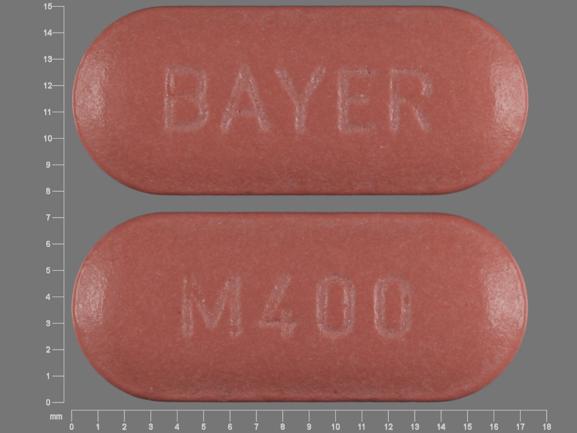Avelox Dosage
Generic name: MOXIFLOXACIN HYDROCHLORIDE 400mg in 250mL
Dosage forms: tablet, film coated, injection, solution
Drug class: Quinolones and fluoroquinolones
Medically reviewed by Drugs.com. Last updated on Sep 4, 2023.
Dosage in Adult Patients
The dose of AVELOX is 400 mg (orally or as an intravenous infusion) once every 24 hours. The duration of therapy depends on the type of infection as described in Table 1.
|
Type of Infectiona |
Dose |
Durationb |
|
Community Acquired Pneumonia (1.1) |
400 mg |
7–14 |
|
Uncomplicated Skin and Skin Structure Infections (SSSI ) (1.2) |
400 mg |
7 |
|
Complicated SSSI (1.3) |
400 mg |
7–21 |
|
Complicated Intra-Abdominal Infections (1.4) |
400 mg |
5–14 |
|
Plague (1.5)C |
400 mg |
10–14 |
|
Acute Bacterial Sinusitis (ABS) (1.6) |
400 mg |
10 |
|
Acute Bacterial Exacerbation of Chronic Bronchitis (ABECB) (1.7) |
400 mg |
5 |
- a)
- Due to the designated pathogens [see Indications and Usage (1)].
- b)
- Sequential therapy (intravenous to oral) may be instituted at the discretion of the physician
- c)
- Drug administration should begin as soon as possible after suspected or confirmed exposure to Yersinia pestis.
Conversion of Intravenous to Oral Dosing in Adults
Intravenous formulation is indicated when it offers a route of administration advantageous to the patient (for example, patient cannot tolerate an oral dosage form). When switching from intravenous to oral formulation, no dosage adjustment is necessary. Patients whose therapy is started with AVELOX Injection may be switched to AVELOX Tablets when clinically indicated at the discretion of the physician.
Important Administration Instructions
AVELOX Tablets
With Multivalent Cations
Administer AVELOX Tablets at least 4 hours before or 8 hours after products containing magnesium, aluminum, iron or zinc, including antacids, sucralfate, multivitamins and didanosine buffered tablets for oral suspension or the pediatric powder for oral solution [see Drug Interactions (7.1) and Clinical Pharmacology (12.3)].
AVELOX Injection
Administer by Intravenous infusion only. It is not intended for intra-arterial, intramuscular, intrathecal, intraperitoneal, or subcutaneous administration.
Administer by intravenous infusion over a period of 60 minutes by direct infusion or through a Y-type intravenous infusion set which may already be in place. Avoid rapid or bolus intravenous infusion.
Parenteral drug products should be inspected visually for particulate matter and discoloration prior to administration, whenever solution and container permit.
Discard any unused portion because the premix flexible containers are for single-use only.
Drug and Diluent Compatibilities
Because only limited data are available on the compatibility of AVELOX intravenous injection with other intravenous substances, additives or other medications should not be added to AVELOX Injection or infused simultaneously through the same intravenous line. If the same intravenous line or a Y-type line is used for sequential infusion of other drugs, or if the “piggyback” method of administration is used, the line should be flushed before and after infusion of AVELOX Injection with an infusion solution compatible with AVELOX Injection as well as with other drug(s) administered via this common line.
Compatible Intravenous Solutions: AVELOX Injection is compatible with the following intravenous solutions at ratios from 1:10 to 10:1:
0.9% Sodium Chloride Injection, USP
1 Molar Sodium Chloride Injection
5% Dextrose Injection, USP
Sterile Water for Injection, USP
10% Dextrose for Injection, USP
Lactated Ringer’s for Injection
Preparation for Administration of AVELOX Injection
Refer to complete directions that have been provided with the administration set.
To prepare AVELOX Injection premix in flexible containers:
- Close flow control clamp of administration set.
- Remove cover from port at bottom of container.
- Insert piercing pin from an appropriate transfer set (for example, one that does not require excessive force, such as ISO compatible administration set) into port with a gentle twisting motion until pin is firmly seated.
More about Avelox (moxifloxacin)
- Check interactions
- Compare alternatives
- Reviews (161)
- Drug images
- Latest FDA alerts (7)
- Side effects
- During pregnancy
- Drug class: quinolones and fluoroquinolones
- Breastfeeding
- En español
Patient resources
- Avelox drug information
- Avelox oral/injection
- Avelox (Moxifloxacin Injection)
- Avelox (Moxifloxacin Tablets)
Professional resources
Other formulations
Related treatment guides
Further information
Always consult your healthcare provider to ensure the information displayed on this page applies to your personal circumstances.


